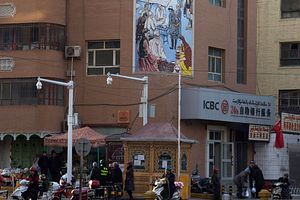Trans-Pacific View author Mercy Kuo regularly engages subject-matter experts, policy practitioners, and strategic thinkers across the globe for their diverse insights into U.S. Asia policy. This conversation with Darren Byler – an anthropology doctoral candidate at the University of Washington – is the 121st in “The Trans-Pacific View Insight Series.”
Briefly explain why China is collecting Uyghur DNA data, according to a recent report.
The state is collecting biometric data from the Uyghur population as part of a new identification card system. Along with DNA collection, they are creating a registry of fingerprints, blood types, voice patterns, facial imagery – all of which will be correlated to ethnicity, employment, gender, age, foreign travel history, household registration, individual and family criminal history, and religious practice.
Since the beginning of the “People’s War on Terror” in the spring of 2014, the Uyghur population in southern Xinjiang has been subject to a number of experiments in policing. The first passbook ID system that was implemented in Xinjiang was called a People’s Convenience Card (bianminka) system. The vast majority of Uyghurs, particularly the more than 80 percent that are classified as rural, were not permitted to get this “good citizen” card and thus were prevented from leaving their home counties by militarized checkpoints. The state discontinued this passbook system in 2016 and has since installed ID checkpoints throughout every town and county in southern Xinjiang. The new ID system will track the movement and communication of Uyghurs throughout every aspect of daily life. In effect, the Chinese state is weaponizing biomedicine to target and control a population of 11 million Uyghurs.
How is the Uyghur population responding to the Chinese government’s collection methods?
One of the ways the state has framed this data collection is as a public health initiative. Using a program called “Physicals for All,” state workers have allegedly collected samples from nearly 19 million inhabitants in Xinjiang. Since the total population of Xinjiang is less than 22 million, this participation rate is unusually high. In fact, the participation rate among Uyghurs is likely near 100 percent – signaling that this is more than simply a public health initiative and that there are strong elements of coercion involved in the collection of data. Uyghurs have long been suspicious of public health initiatives, since they have often been associated with state control of individual life choices. Now, despite their antipathy toward state health institutions, the police state has compelled them to participate in biodata collection or face detention as religious “extremists.”
Explain the correlation between China’s household registration system and DNA collection in Xinjiang.
One of the ways DNA appears to be used in the new biometric security system is to track down Uyghurs that had not previously been counted in the household registration (hukou) system. For many years, Uyghurs who did not move with a parent into a new household following a divorce were often not counted as that parent’s children. Because of this the parent was able to have two to three additional children in a new household. Uyghurs also often gave “extra” children to relatives or bribed local officials so that they would not be forced to pay heavy fines and face legal repercussions. Now DNA matching is being used to detect the biological relations between these parents and children. They are being retroactively penalized and forced to pay fines or face detention. From the state’s perspective, the new biometric ID system is a way of counteracting the tactics of resistance to state control that Uyghurs have employed for decades.
What are potential socio-cultural consequences for China’s other ethnic minorities?
Since one of the priorities of the state is to slow increases in the growth of the Uyghur population while increasing the Han population in Xinjiang, it is likely that this data will be used to increase Han dominance in the region by preventing “illegal” Uyghur births. There are already many signs that the new ID system is also being used to regulate Kazakh and Hui populations in Xinjiang. Many members of these other Muslim minorities have also now been detained and sent to fortified reeducation centers under suspicion of religious “extremism” particularly in northern parts of the province where there are fewer Uyghurs to meet centrally-imposed detention quotas. There is no evidence that the new ID system will be used to target non-Muslim minorities, but I would not be surprised if we see similar developments in Tibet in the near future.
What are the policy implications of China’s biodata collection in Xinjiang?
This may be a system that will eventually be rolled out across the nation. India is in the midst of implementing a similar biometric ID system. For India, the primary goals appear to be generating greater tax revenue and addressing the widespread production of false documents. I imagine that biometric data could be used for similar purposes among the Han population outside of Xinjiang. In Xinjiang, though, the primary goal is to prevent the movement of Muslim populations and to tightly control all communications within these groups. Since Uyghurs have no legal representation and virtually no institutional support, the Chinese state is free to experiment on them as they wish. The resonance between the eugenics movement that was widespread in America and Western Europe in the 1940s and the contemporary Chinese weaponization of biomedicine is not lost on them. This is why there is widespread fear among Uyghurs that the biometric data may be used to selectively harvest the organs of thousands of Uyghurs that have disappeared behind what they refer to as “the black gate” (qara dervaza) of the mass detention system.

































